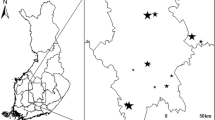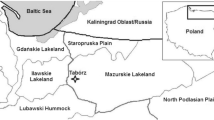Abstract
Studies on the relation of the diversity of wood-decaying fungi to elevation are scarce, and their results are not consistent. We found that the elevation gradient and structural characteristics of a Picea abies forest underlie changes in the species richness and composition of wood-decomposing fungi. The occurrence of macrofungal sporocarps on logs on the ground was recorded over 3 years in 12 study plots (total area 2.4 ha) on a mountain slope (1,220–1,335 m) in the Bohemian Forest, Czech Republic. The majority of species was more abundant in plots with a high mean volume of logs. The mean volume of logs was negatively related to elevation, which in turn had a negative influence on the occurrence of fungi. A negative relation of the high total volume of standing snags to the occurrence of fungi may be due to recent mortality caused by a bark beetle outbreak, albeit followed by the input of fresh logs that favoured a limited group of species. The diversity of fungi was also explained by the mean volumes of logs separated into decay classes. Numbers of red-listed species increased with the mean volume of logs and decreased with elevation. Large logs in later stages of decay provide essential habitat for the formation of sporocarps of red-listed species.




Similar content being viewed by others
References
Allmér J (2005) Fungal communities in branch litter of Norway spruce: dead wood dynamics, species detection and substrate preferences. Dissertation, Swedish University of Agricultural Sciences
Bader P, Jansson S, Jonsson BG (1995) Wood-inhabiting fungi and substratum decline in selectively logged boreal spruce forests. Biol Conserv 72:355–362. doi:10.1016/0006-3207(94)00029-P
Begon M, Harper JL, Townsend CR (1990) Ecology. Individuals, populations and communities, 2nd edn. Blackwell, Boston, p 59
Berglund H, Jonsson BG (2001) Predictability of plant and fungal species richness of old-growth boreal forest islands. J Veg Sci 12:857–866
Delaney M, Brown S, Lugo AE, Torres-Lezama A, Quintero NB (1998) The quantity and turnover of dead wood in permanent forest plots in six life zones of Venezuela. Biotropica 30:2–11. doi:10.1111/j.1744-7429.1998.tb00364.x
Doležal J, Šrůtek M (2002) Altitudinal changes in composition and structure of mountain-temperate vegetation: a case study from the Western Carpathians. Plant Ecol 158:201–221
Edman M, Gustafsson M, Stenlid J, Ericson L (2004a) Abundance and viability of fungal spores along a forestry gradient—responses to habitat loss and fragmentation? Oikos 104:35–42. doi:10.1111/j.0030-1299.2004.12454.x
Edman M, Kruys N, Jonsson BG (2004b) Local dispersal sources strongly affect colonisation patterns of wood-decaying fungi on spruce logs. Ecol Appl 14:893–901. doi:10.1890/03-5103
Edman M, Jönsson M, Jonsson BG (2007) Fungi and wind strongly influence the temporal availability o flogs in an old-growth spruce forest. Ecol Appl 17:482–490. doi:10.1890/06-0852
Fischer A, Lindner M, Abs C, Lasch P (2002) Vegetation dynamics in central European forest ecosystems (near-natural as well as managed) after storm events. Folia Geobot 37:17–32
Hansen L, Knudsen H (eds) (1997) Nordic Macromycetes. Heterobasidioid, Aphyllophoroid and Gasteromycetoid Basidiomycetes, vol 3. Nordsvamp, Copenhagen
Hansen L, Knudsen H (eds) (2000) Nordic Macromycetes. Ascomycetes, vol 1. Nordsvamp, Copenhagen
Harmon ME, Krankina ON, Sexton J (2000) Decomposition vectors: a new approach to estimating wood detritus decomposition dynamics. Can J For Res 30:76–84. doi:10.1139/cjfr-30-1-76
Heilmann-Clausen J (2001) A gradient analysis of communities of macrofungi and slime moulds on decaying beech logs. Mycol Res 105:575–596. doi:10.1017/S0953756201003665
Heilmann-Clausen J, Christensen M (2004) Does size matter? On the importance of various dead wood fractions for fungal diversity in Danish beech forests. Forest Ecol Manag 201:105–117. doi:10.1016/j.foreco.2004.07.010
Heilmann-Clausen J, Christensen M (2005) Wood-inhabiting macrofungi in Danish beech-forests—conflicting diversity patterns and their implications in a conservation perspective. Biol Conserv 122:633–642. doi:10.1016/j.biocon.2004.10.001
Heilmann-Clausen J, Christensen M (2009) Forest biodiversity gradients and the human impact in Annapurna Conservation Area, Nepal. Biodivers Conserv 18:2205–2221. doi:10.1007/s10531-009-9583-9
Heilmann-Clausen J, Aude E, Christensen M (2005) Cryptogam communities on decaying deciduous wood—does tree species diversity matter? Biodivers Conserv 14:2061–2078. doi:10.1007/s10531-004-4284-x
Høiland K, Bendiksen E (1997) Biodiversity of wood-inhabiting fungi in a boreal coniferous forest in Sør-Trøndelag County, Central Norway. Nordic J Bot 16:643–659. doi:0.1111/j.1756-1051.1996.tb00283.x
Holec J, Beran M (eds) (2006) Červený seznam hub (makromycetů) České republiky [Red List of fungi (macromycetes) of the Czech Republic]. Příroda 24, 1–282, Praha
Holeksa J, Saniga M, Szwagrzyk J, Dziedzic T, Ferenc S, Wodka M (2007) Altitudinal variability of stand structure and regeneration in the subalpine spruce forests of the Poľana biosphere reserve, Central Slovakia. Eur J Forest Res 126:303–313. doi:10.1007/s10342-006-0149-z
Horak E (2005) Röhrlinge und Blätterpilze in Europa. 6., (völling neu bearbeite Auflage fußend auf Moser, 5. Auflage (1983): Kleine Kryptogamenflora, Band II, Teil b2. Gustav Fisher Verlag) Elsevier, Spektrum Akademischer Verlag, München
Jonsson BG, Kruys N, Ranius T (2005) Ecology of species living on dead wood—lessons for dead wood management. Silva Fenn 39:289–309
Jönsson MT, Edman M, Jonsson BG (2008) Colonization and extinction patterns of wood-decaying fungi in a boreal old-growth Picea abies forest. J Ecol 96:1065–1075. doi:10.1111/j.1365-2745.2008.01411.x
Junninen K, Similä M, Kouki J, Kotiranta H (2006) Assemblages of wood-inhabiting fungi along the gradients of succession and naturalness in boreal pine-dominated forests in Fennoscandia. Ecography 29:75–83. doi:10.1111/j.2005.0906-7590.04358.x
Körner C (2007) The use of ‘altitude’ in ecological research. Trends Ecol Evol 22:569–574. doi:10.1016/j.tree.2007.09.006
Korpel’ Š (1995) Die Urwälder der Westkarpaten. Gustav Fischer Verlag, Stuttgart Jena New York
Kruys N, Jonsson BG (1999) Fine woody debris is important for species richness on logs in managed boreal spruce forests of northern Sweden. Can J For Res 29:1295–1299
Kruys N, Fries C, Jonsson BG, Lämås T, Ståhl G (1999) Wood inhabiting cryptogams on dead Norway spruce (Picea abies) trees in managed Swedish boreal forest. Can J For Res 29:178–186
Küffer N, Senn-Irlet B (2005a) Influence of forest management on the species richness and composition of wood-inhabiting basidiomycetes in Swiss forests. Biodivers Conserv 14:2419–2435. doi:10.1007/s10531-004-0151-z
Küffer N, Senn-Irlet B (2005b) Diversity and ecology of wood-inhabiting aphyllophoroid basidiomycetes on fallen woody debris in various forest types in Switzerland. Mycol Prog 4:77–86
Lepš J, Šmilauer P (2003) Multivariate analysis of ecological data using CANOCO. Cambridge University Press, Cambridge
Lindblad I (1998) Wood-inhabiting fungi on fallen logs of Norway spruce: relations to forest management and substrate quality. Nordic J Bot 18:243–255. doi:10.1111/j.1756-1051.1998.tb01877.x
Lindblad I (2001) Diversity of poroid and some corticoid wood-inhabiting fungi along the rainfall gradient in tropical forests, Costa Rica. J Trop Ecol 17:353–369. doi:10.1017/S0266467401001249
Lonsdale D, Pautasso M, Holdenrieder O (2008) Wood-decaying fungi in the forest: conservation needs and management options. Eur J Forest Res 127:1–22. doi:10.1007/s10342-007-0182-6
Maphosa L, Wingfield BD, Coetzee MPA, Mwenje E, Wingfield MJ (2006) Phylogenetic relationships among Armillaria species inferred from partial elongation factor 1-alpha DNA sequence data. Australas Plant Pathol 35:513–520. doi:10.1071/AP06056
Mehrotra BS, Harsh NSK, Bisht NS (1983) Altitudinal distribution of some common wood-rotting fungi in Kumaun hills. Int J Trop Plant Dis 1:87–91
Müller J, Engel H, Blaschke M (2007) Assemblages of wood-inhabiting fungi related to silvicultural management intensity in beech forests in southern Germany. Eur J Forest Res 126:513–527. doi:10.1007/s10342-007-0173-7
Müller J, Bußler H, Goßner M, Rettelbach T, Duelli P (2008) The European spruce bark beetle Ips typographus in a national park: from pest to keystone species. Biodivers Conserv 17:2979–3001. doi:10.1007/s10531-008-9409-1
Nagel TA, Svoboda M (2008) Gap disturbance regime in an old-growth Fagus-Abies forest in the Dinaric Mountains, Bosnia-Herzegovina. Can J For Res 38:2728–2737. doi:10.1139/X08-110
Neuhäuslová Z (ed) (2001) The map of potential natural vegetation of the Šumava National Park. Silva Gabreta, Supplement 1
Neuhäuslová Z, Moravec J (eds) (1997) Map of potential natural vegetation of the Czech Republic. Botanický ústav AVČR
Nogués-Bravo D, Araújo MD, Romdal T, Rahbek C (2008) Scale effects and human impact on the elevational species richness gradients. Nature 453:216–218. doi:10.1038/nature06812
Nordén B, Paltto H (2001) Wood-decay fungi in hazel wood: species richness correlated to stand age and dead wood features. Biol Conserv 101:1–8. doi:10.1016/S0006-3207(01)00049-0
Nordén B, Ryberg M, Götmark F, Olausson B (2004) Relative importance of coarse and fine woody debris for the diversity of wood-inhabiting fungi in temperate broadleaf forests. Biol Conserv 117:1–10. doi:10.1016/S0006-3207(03)00235-0
Núñez M (1996) Fructification of Polyporaceae s.l. (Basidiomycotina) along a gradient of altitude and humidity in the Guanacaste Conservation Area (Costa Rica). J Trop Ecol 12:893–898
Penttilä R, Siitonen J, Kuusinen M (2004) Polypore diversity in managed and old-growth boreal Picea abies forests in southern Finland. Biol Conserv 117:271–283. doi:10.1016/j.biocon.2003.12.007
Penttilä R, Lindgren M, Miettinen O, Rita H, Hanski I (2006) Consequences of forest fragmentation for polyporous fungi at two spatial scales. Oikos 114:225–240. doi:10.1111/j.2006.0030-1299.14349.x
Rayner ADM (1992) Introduction. In: Carroll GC, Wicklow DT (eds) The fungal community: its organization and role in the ecosystem, 2nd edn. Marcel Dekker, New York
Renvall P (1995) Community structure and dynamics of wood-rotting Basidiomycetes on decomposing conifer trunks in northern Finland. Karstenia 35:1–51
Romdal TS, Grytnes J-A (2007) An indirect area effect on elevational species richness patterns. Ecography 30:440–448. doi:10.1111/J.2007.0906-7590.04954.x
Ryvarden L, Gilbertson RL (1993) European Polypores. Part 1. Abortiporus—Lindtneria. Synopsis Fungorum 6, Fungiflora, Oslo
Ryvarden L, Gilbertson RL (1994) European Polypores. Part 2. Meripilus—Tyromyces. Synopsis Fungorum 7, Fungiflora, Oslo
Sippola A-L, Renvall P (1999) Wood-decomposing fungi and seed tree cutting: a 40-year perspective. Forest Ecol Manag 115:183–201. doi:10.1016/S0378-1127(98)00398-3
Sippola A-L, Lehesvirta T, Renvall P (2001) Effects of selective logging on coarse woody debris and diversity of wood-decaying polypores in eastern Finland. Ecol Bull 49:243–254
Splechtna BE, Gratzer G, Black BA (2005) Disturbance history of a European old-growth mixed-species forest—a spatial dendro-ecological analysis. J Veg Sci 16:511–522
Stokland JN (2001) The coarse woody debris profile: an archive of recent forest history and an important biodiversity indicator. Ecol Bull 49:71–83
Stokland J, Kauserud H (2004) Phellinus nigrolimitatus—a wood-decomposing fungus highly influenced by forestry. Forest Ecol Manag 187:333–343. doi:10.1016/j.foreco.2003.07.004
Svoboda M (2007) Les ve druhé zóně v oblasti Trojmezné není hospodářskou smrčinou: změní se management dříve než vznikne rozsáhlá asanovaná plocha? [The origin of the forest in the second zone next to Trojmezná old-growth forest is natural: does the management change before it will be cut down?]. Silva Gabreta 13:171–187 [in Czech with English abstract]
Svoboda M, Pouska V (2008) Structure of a Central-European mountain spruce old-growth forest with respect to historical development. Forest Ecol Manag 255:2177–2188. doi:10.1016/j.foreco.2007.12.031
Szwagrzyk J, Szewczyk J (2001) Tree mortality and effects of release from competition in an old-growth Fagus-Abies-Picea stand. J Veg Sci 12:621–626
R development core team (2008a) R Reference Index. R Foundation for Statistical Computing, Vienna. http://www.R-project.org
R development core team (2008b) R: a language and environment for statistical computing. R Foundation for Statistical Computing, Vienna. http://www.R-project.org
ter Braak CJF, Šmilauer P (2003) Canoco 4.5. Biometris. Plant Research International, Wageningen
Tolasz R, Míková T, Valeriánová A, Voženílek V (eds) (2007) Climate atlas of Czechia. Czech Hydrometeorological Institute, Praha Olomouc
Vacher C, Vile D, Helion E, Piou D, Desprez-Loustau M-L (2008) Distribution of parasitic fungal species richness: influence of climate versus host species diversity. Divers Distrib 14:786–798. doi:10.1111/j.1472-4642.2008.00479.x
Weir JR (1918) Notes on the altitudinal range of forest fungi. Mycologia 10:4–14
White NA (2004) The importance of wood-decay fungi in forest ecosystems. In: Arora DK (ed) Fungal biotechnology in agricultural, food and environmental applications. Marcel Dekker, New York, pp 375–392
Acknowledgments
We thank V. Antonín, M. Beran, S. Komínková, O. Koukol, V. Kučera, S. Ripková, J. D. Rogers, M. Tomšovský, F. Tondl and J. Vlasák for help with identification of fungi, and L. Sládková and V. Struhal for help during the fieldwork. We are grateful to J. Lepš for valuable comments on the manuscript. We thank D. Hardekopf for revising the English. Comments by two anonymous reviewers have greatly improved the earlier version of the manuscript. Šumava National Park and M. Pavlíčko provided technical support. This study was supported by the Grant agency of the Academy of Sciences of the CR (KJB601300602), by the Ministry of Environment (VaV MŽP SP/2d2/111/08) and by the Ministry of Education (MSM6007665801).
Author information
Authors and Affiliations
Corresponding author
Additional information
Communicated by R. Matyssek.
Rights and permissions
About this article
Cite this article
Pouska, V., Svoboda, M. & Lepšová, A. The diversity of wood-decaying fungi in relation to changing site conditions in an old-growth mountain spruce forest, Central Europe. Eur J Forest Res 129, 219–231 (2010). https://doi.org/10.1007/s10342-009-0324-0
Received:
Revised:
Accepted:
Published:
Issue Date:
DOI: https://doi.org/10.1007/s10342-009-0324-0




